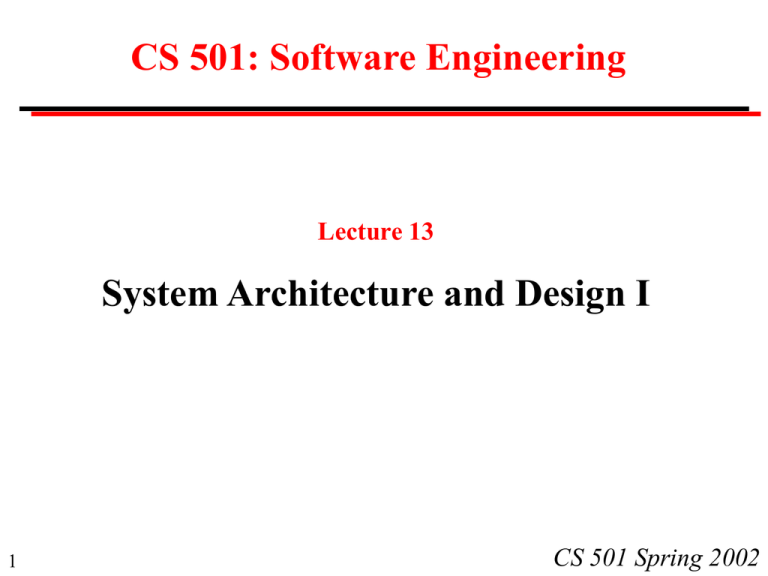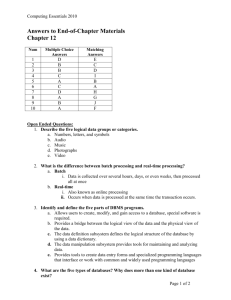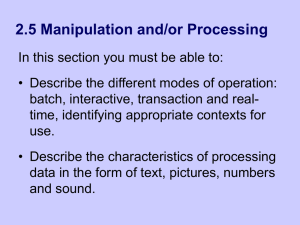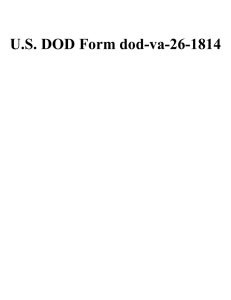CS 501: Software Engineering System Architecture and Design I Lecture 13
advertisement

CS 501: Software Engineering Lecture 13 System Architecture and Design I 1 CS 501 Spring 2002 Administration • Quiz 2. Pick up after class or from Rosemary Adessa, Upson 5147 • Assignment 2. Remember to submit (a) requirements report (b) individual questionnaires • Project presentations on Wedneday afternoon. Can you start 15 minutes earlier than scheduled? 2 CS 501 Spring 2002 Project Presentations Requirements Requirements Analysis System design Design Program design Implementation Coding Unit & Integration Testing System Testing Acceptance Testing Operation & Maintenance 3 CS 501 Spring 2002 System Architecture and Design The overall design of a system: • • • • • • 4 Computers and networks (e.g., monolithic, distributed) Interfaces and protocols (e.g., http, CORBA) Databases (e.g., relational, distributed) Security (e.g., smart card authentication) Operations (e.g., backup, archiving, audit trails) Software environments (e.g., languages, source control tools) CS 501 Spring 2002 A. Data Intensive Systems Examples • Electricity utility customer billing • Telephone company call recording and billing • Car rental reservations (e.g., Hertz) • Stock market brokerage (e.g., Charles Schwab) • E-commerce (e.g., Amazon.com) 5 CS 501 Spring 2002 Data Intensive Systems Example 1: Electricity Utility Billing First attempt: Transaction Data input Master file Bill Each transaction handled as it arrives. 6 CS 501 Spring 2002 Criticisms of First Attempt Where is this first attempt weak? • A bill is sent out for each transaction, even if there are several per day • Bills are not sent out on a monthly cycle • No way to answer customer queries • No process for error checking and correction • All activities are triggered by a transaction The requirements have not been specified!!! 7 CS 501 Spring 2002 Transaction Types • • • • • • • • 8 Create account / close account Meter reading Payment received Other credits / debits Check cleared / check bounced Account query Correction of error etc., etc., etc., CS 501 Spring 2002 Typical Requirements • All payments to be credited on day received • Customers must be able to query account by telephone • Cutting off service for non-payment requires management authorization • Data input staff should process n transactions per day per person • Error rate must be below 0.01% • System available 99.9% of business hours 9 CS 501 Spring 2002 Batch Processing: Validation errors Edit & validation Incoming transactions Validated transactions Data input read only Master file 10 CS 501 Spring 2002 Batch Processing: Master File Update Validated transactions in batches errors Sort by account Master file update 11 Reports Bills Instructions CS 501 Spring 2002 Benefits of Batch Updating • All transactions for an account are processed together at appropriate intervals • Backup and recovery have fixed checkpoints • Better management control of operations • Efficient use of staff and hardware 12 CS 501 Spring 2002 Online Inquiry Customer Service read only New transaction Master file Customer Service department can read file, make annotations, and create transactions, but not change the master file. 13 CS 501 Spring 2002 Data Intensive Systems Example 2: A Small-town Stockbroker • Transactions Received by mail or over telephone For immediate or later action 14 • Complex customer inquiries • Highly competitive market CS 501 Spring 2002 A Database Architecture Database(s): • Customer and account database • Financial products (e.g., account types, pension plans, savings schemes) • Links to external databases (e.g., stock markets, mutual funds, insurance companies) 15 CS 501 Spring 2002 Database Architecture Products & services database 16 Customer & account database External services CS 501 Spring 2002 Real-time Transactions Real-time transactions Products & services database 17 Customer & account database External services CS 501 Spring 2002 Real-time Transactions & Batch Processing Real-time transactions Products & services database 18 Data input Batch processing Customer & account database External services CS 501 Spring 2002 Architectural considerations • Real-time service during scheduled hours with batch processing overnight • Combine information from several databases • Database consistency after any type of failure two-phase commit reload from checkpoint + log detailed audit trail • How will transaction errors be avoided? • How will transaction errors be corrected? • How will staff dishonesty be controlled? 19 CS 501 Spring 2002 Data Intensive Systems Example 3: Merger of Two Banks Each bank has a database with its customer accounts. The databases are used by staff at many branches and for back-office processing. The requirement is to integrate the two banks so that they appear to the customers to be a single organization and to provide integrated service from all branches. This is an example of working with legacy systems. 20 CS 501 Spring 2002 Merger of Two Banks: Options A ??? B ??? 21 CS 501 Spring 2002 Merger of Two Banks: Architectural Options I. Convert everything to System A: convert databases retrain staff enhance System A (software and hardware) discard System B II. Build an interface between the databases in System A and System B. III. Extend client software so that it can interact with either System A or System B database. 22 CS 501 Spring 2002 Discussion of Pfleeger, Chapter 5 Format: State a question. Ask a member of the class to answer. (Sorry if I pronounce your name wrongly.) Provide opportunity for others to comment. When answering: Stand up. Give your name or NetID. Make sure the TA hears it. Speak clearly so that all the class can hear. 23 CS 501 Spring 2002 Question 1: Design Review (a) What is the purpose of a design review? (b) Suppose that you are organizing a preliminary design review: i Who should be present? ii What role does each individual have? (c) What do you see as the benefits of a preliminary design review? 24 CS 501 Spring 2002 Question 2: Architectural Styles Explain the following seven architectural styles identified by Shaw and Garlan. Give examples. What are the benefits of each? (a) (b) (c) (d) (e) (f) (g) pipes and filters objects implicit invocation (event-driven) layering repositories interpreters process control Do you have a preferred style? 25 CS 501 Spring 2002 Question 3: Collaboration Suppose that you developing a major real-time system in the United States (e.g., a parcel tracking system for Federal Express). The programming will be subcontracted to one of the leading software houses in India. (a) How would you organize the project to accommodate this arrangement? (b) Suppose that at a late stage in the project it was decided to use a different subcontractor somewhere else in the world. What factors would you be paying special attention to? 26 CS 501 Spring 2002 Question 4: Components (a) What does it mean to say that components are highly coupled or loosely coupled? What factors determine the degree of coupling? (b) Would you expect object oriented components to he highly coupled? (c) Distinguish between: i content coupling and common coupling ii stamp coupling and data coupling (d) What is component cohesion? 27 CS 501 Spring 2002 Question 5: Techniques for Improving Design The book has four topics under this heading. What are the strengths and difficulties with each? When would each be used? 28 (a) Prototyping design (b) Fault-tree analysis (c) Design by contract (d) Reducing complexity CS 501 Spring 2002





